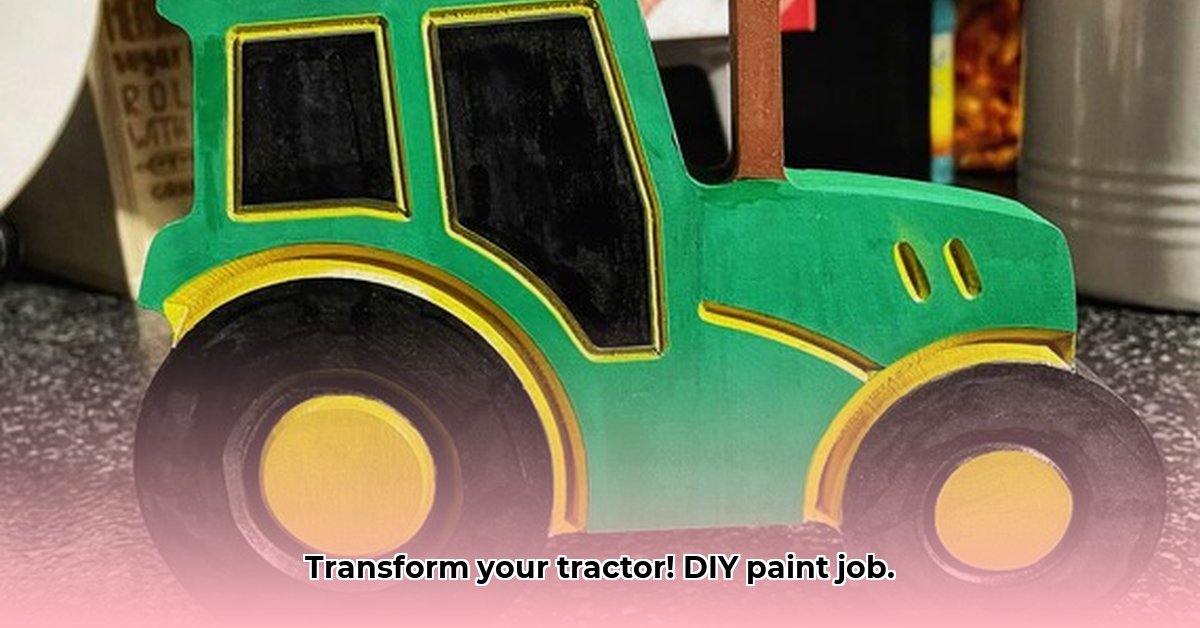
Want to revitalize your old tractor with a brand-new look? This comprehensive guide provides a step-by-step approach to hand-painting your tractor, achieving a professional finish whether you're a seasoned DIYer or a complete beginner. We'll cover everything from surface preparation to choosing the right paint, ensuring your tractor looks its best for years to come. For high-quality tractor paint, check out Valspar options.
Getting Started: Preparing Your Tractor for a Perfect Paint Job
Before you even think about paint, meticulous preparation is key. A thorough prep job ensures your paint adheres properly, preventing peeling and chipping, and ultimately resulting in a long-lasting, professional-looking finish. Don't rush this stage; it's the foundation of your project's success. Did you know that 90% of a successful paint job relies on proper preparation?
Deep Cleaning: Removing Dirt and Grime
First, give your tractor a thorough cleaning. A pressure washer is ideal for blasting away ingrained dirt, mud, and grime. Follow up with a degreaser to remove stubborn grease and oil. Allow the tractor to dry completely before proceeding. Painting on a damp surface will lead to adhesion issues and a subpar finish.
Addressing Imperfections: Repairing Rust and Dents
Carefully inspect your tractor for any damage. Small dents can often be sanded out, but larger ones may require more extensive repairs. Address any rust spots using a rust remover (following product instructions carefully). Remember, rust compromises paint adhesion. Once repairs are complete, sand the affected areas smooth for a uniform surface.
Sanding for a Smooth Surface: Patience is Key
Sanding is crucial for achieving a flawless finish. Start with coarser grit sandpaper (80-grit) to remove imperfections, gradually progressing to finer grits (220-grit) for a super-smooth surface. Sand in the direction of the metal grain and wear a dust mask to protect your lungs. This step is essential for optimal paint adhesion and a professional-looking result. Think of this as creating a canvas for your masterpiece!
Masking: Protecting Unpainted Areas
Once the surface is prepped, meticulously mask off areas you don't want to paint, such as windows, lights, and decals. Use high-quality painter's tape and masking paper to ensure clean lines and a professional-looking finish. This is worth the extra time invested; sharp lines make all the difference!
Choosing Your Paint and Gathering Your Supplies
Selecting the right paint is paramount to a long-lasting, durable finish. Avoid shortcuts here; investing in high-quality paint will pay off in the long run. "Using inferior paint is like building a house on a weak foundation," says John Miller, a veteran restoration expert at Classic Tractor Restorations.
Paint Durability and Type: Key Considerations
Opt for high-quality exterior paint designed for machinery. Look for paints rated for UV resistance, chipping resistance, and fading resistance. Consider water-based (easier cleanup) or solvent-based (oil-based, more durable) options, depending on your priorities.
Color Selection: Personal Preference vs. Practicality
Choose a color that you love, but consider your climate. Lighter colors reflect more sunlight, potentially reducing heat build-up.
Essential Tools and Safety Gear
- Brushes or Rollers: For detailed or large areas respectively.
- Spray Gun (Optional): For a professional finish (requires practice).
- Paint Trays: Essential for brushes and rollers.
- Safety Gear: Gloves, eye protection, and a respirator (especially for solvent-based paints and sanding). This is non-negotiable; your safety is paramount.
Painting Your Tractor: A Step-by-Step Guide
With your preparation complete and supplies gathered, let's get painting!
Primer Application: Apply a high-quality metal primer for improved paint adhesion. Allow it to dry completely before proceeding.
First Coat: Apply your first coat of paint, using thin, even strokes. Several thin coats are preferable to one thick coat which may likely run or drip.
Subsequent Coats: Allow each coat to dry completely (check the paint can for drying times) before applying the next. Aim for 2-3 coats for optimal coverage and durability. The result? A stunning finish.
Final Touches: Once the final coat is dry, carefully remove the masking tape. Address any minor touch-ups needed. Let everything dry completely once again.
Maintaining Your Tractor's New Look: Long-Term Care
Congratulations! You now have a beautifully repainted tractor. Proper maintenance will ensure your hard work lasts.
Regular Cleaning: Wash your tractor regularly with soap and water to remove dirt and debris.
Waxing for Protection: Waxing adds an extra layer of protection against the elements, preserving your paint job's shine and longevity. It's a small effort for a substantial payoff!
Considering Professional Help
If the project feels overwhelming or your tractor requires extensive repairs, consider hiring a professional. While more expensive, it guarantees a flawless finish, especially crucial for complex restoration projects.
This detailed guide provides you with the knowledge and steps to achieve a stunning repaint on your tractor. Remember, proper preparation and patience are key to success. Share your experience and results; we'd love to see your handiwork!